Silicone hydrogel lenses represent a major step
forward in the development of vision correction, offering our
patients convenience, comfort and good vision.
Are patients happy with silicone hydrogels? Patients enjoy the
freedom of 30 days and nights of continuous wear together with
the advantages of soft lenses, and rapidly increasing sales figures
indicate that the lenses are being warmly welcomed in the marketplace.
Are practitioners happy with silicone hydrogels? Practitioners
are seeing high levels of patient satisfaction and good corneal
health with the lenses. Many practitioners are now seeing high
Dk silicone hydrogel lenses as the first choice lens for their
patients, irrespective of wear schedule, because these lenses
offer superior metabolic health for the patient.
Practitioner confidence Practitioners have a major influence on the products used by
their patients. In a landmark study published in 1991, Tony Hanks
showed the difference between a proactive and reactive approach
to prescribing contact lenses [or introducing contact lenses
to patients]. With 50 patients, contact lenses were offered only
if a patient initiated interest. With another 50 patients, the
practitioner raised the topic. Hanks found that lenses were discussed
with only 4% of patients in the first group, resulting in one
fitting In contrast, contact lenses were discussed with 100%
of patients in the second group, and 22% of patients were fitted
with lenses.
The impact of practitioner attitudes on silicone hydrogels was
obvious. Despite patient enthusiasm about the well-publicised
convenience of CW, silicone hydrogel CW had a somewhat slow beginning
because of practitioner wariness about the safety of the modality.
Since then, worldwide studies looking at the performance of
silicone hydrogels have clearly demonstrated that the lenses
have indeed solved the problem of hypoxia with extended wear.
The results of these studies and the positive experiences of
colleagues are now convincing practitioners that the lenses are
a valuable option for all contact lens patients.
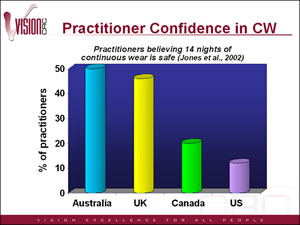 |
| Figure 1 - click to enlarge |
As Figure 1 illustrates, Australia and the UK are
currently leading the world in practitioner confidence. The early
launch of silicone hydrogels in these countries has undoubtedly
contributed to these figures, as practitioners rapidly gain experience
and trust in the new materials once they see their successful
performance in practice. It is expected that the US and Canada
will reach similar levels of confidence in the near future.
Increase in silicone hydrogels
With the change in practitioner attitude we are seeing a significant
increase in worldwide silicone hydrogel use. Silicone hydrogels
are the fastest growing segment of the CL market, with many existing
and new lens wearers attracted to their convenience and health
benefits.
Silicone hydrogel use has doubled in the past year, and it is
estimated that there are now one million high Dk wearers around
the world ( Figure 2 ). In Australia, there was a 46%
growth in value in the silicone hydrogel market in 2001-2002,
and silicone hydrogels now comprise 16% of the total worldwide
CL market.
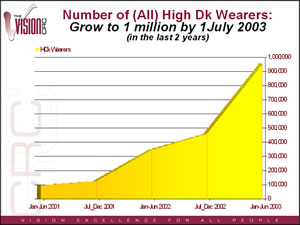 |
| Figure 2 - click to enlarge |
The convenience of extended wear has certainly been one of the
key drivers behind the growth in silicone hydrogel wear, and
myopes have made up a large proportion of the market. The most
recent market growth may be more due to market expansion, however,
as practitioners recognise the value of the lenses for a wider
range of patients.
Silicone hydrogels are increasingly being used for both continuous
and daily wear. The flexibility of wear time makes them an attractive
option for all patients. The lenses also often provide better
comfort than conventional daily lenses, and can be of use for
dry eye patients. The wider choice of powers is also opening
up options for more patients.
Silicone hydrogels have great potential to be used for presbyopic
patients using monovision (see Jacqueline Tan's editorial 'Contact
Lens Options for Presbyopia' from December). Monovision
is the most successful form of contact lens wear for presbyopes,
and silicone hydrogels offer ocular health and the option of
continuous wear. Silicone hydrogel monovision also offers existing
satisfied lens wearers the chance to continue wear as their vision
correction needs change with presbyopia.
Silicone hydrogels are also finding a place as a therapeutic
lens for a range of conditions. Again, the ocular health benefits
of high oxygen permeability combine with the comfort of a soft
lens to make silicone hydrogels an excellent choice as a bandage
lens.
New vs existing
Anecdotal reports indicate that spectacle wearers are attracted
by the convenience of CW; however, there are no specific data
yet available on this aspect of the market. In practitioner surveys
Morgan and Efron have found that silicone hydrogels are more
often used for refits than for new lens fittings ( Figure
3 ).
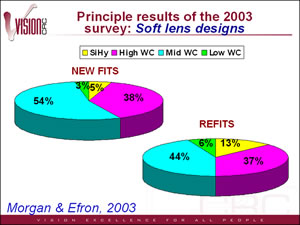 |
| Figure 3 - click to enlarge |
Australian practitioners similarly seem to be more prepared
to prescribe silicone hydrogels for existing CL wearers to silicone
hydrogels than to prescribe new wearers with CW ( Figure
4 ).
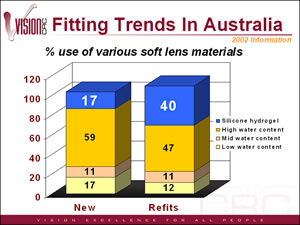 |
| Figure 4 - click to enlarge |
These fitting trends may reflect practitioner caution, wishing
to provide patients with experience in conventional soft lenses
before transferring them to CW. This strategy may provide a valid
test of patient compliance, to ensure that patients do not become
complacent with the additional convenience of CW. It is to be
hoped, however, that patients fitted with conventional lenses
do not become part of the contact lens 'drop out' statistics
before reaching CW.
Usage in Australia
In 2003, a Vision Cooperative Research Centre (VisionCRC) research team led by Fiona Stapleton undertook
a household survey to determine lens prescribing and usage trends
in Australia. 7,865 households (18,192 individuals) were contacted.
The results ( Figure 5 ) show:
- 4.6% penetration of CL wear
- 64% of CL wearers are female
- The figure below illustrates the distribution of practitioners
prescribing trends in Australia where the majority of lenses
that are prescribed are disposable weekly or monthly use for
daily wear. However, silicone hydrogel lenses already constitute
an impressive 5.3%.
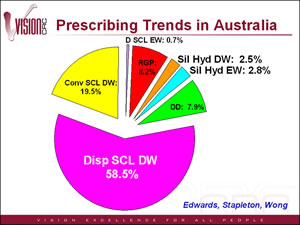 |
| Figure 5 - click to enlarge |
The future
Silicone hydrogels have revolutionised the vision correction
market, and we will continue to see their exciting impact on
patients and practitioners. CL and CW usage figures are rapidly
changing as practitioners gain experience and confidence, as
practitioners recognise their use for a wider patient range,
as more patients express interest in the new lenses, and as additional
designs expand the market. We look forward to seeing how practitioner
confidence and CL use continues to develop throughout the world
over the coming year.
|